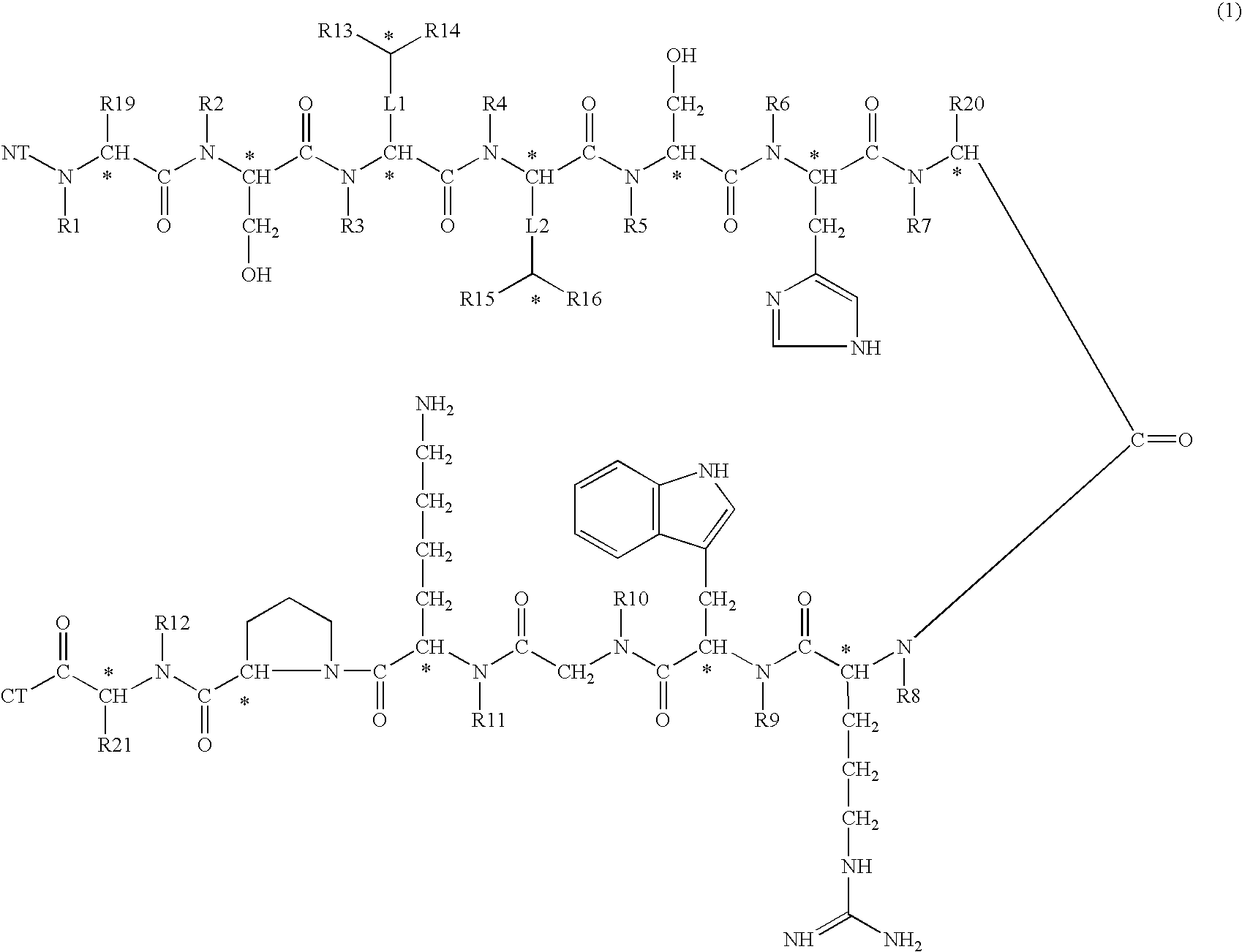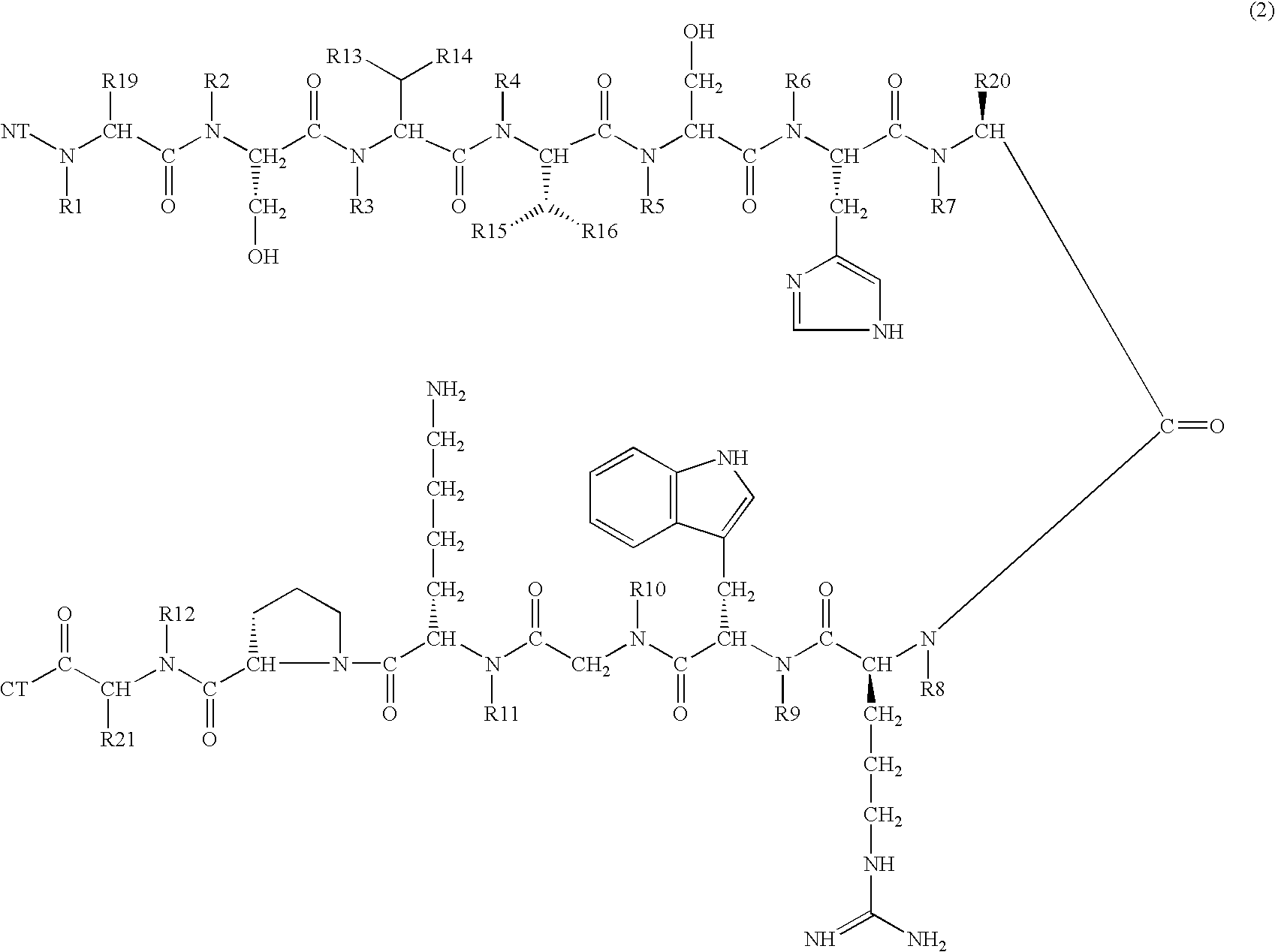Melanocortin 1 receptor selective compounds
a technology of melanocortin and receptor, which is applied in the field of selective compounds of melanocortin 1 receptor, can solve the problems of low stability, inferior properties of peptides, and limited selectivity of mc-receptors versus other subtypes of mc-receptors
- Summary
- Abstract
- Description
- Claims
- Application Information
AI Technical Summary
Benefits of technology
Problems solved by technology
Method used
Image
Examples
example 1
[0218]Synthesis of Ser-Ser-Ile-Ile-Ser-His-NMedPhe-Arg-Trp-Gly-Lys-Pro-Val-NH2 (MS-42) (SEQ ID NO:15) tetratrifluoroacetate was made essentially as described in Example 1.
[0219]Fmoc-NMedPhe-OH was added using PyAOP.
[0220]Yield 40%. Rf 0.70. k′ 2.5 (10.8% MeCN in 0.1% TFA). m / e 1527.0.
example 2
Assay of Binding Affinities of Compounds of the Invention for Human MC-Receptors
[0221]Expression of receptor clones. Human MC1- and MC5-receptor DNAs (Chhajlani and Wikberg 1992; Chhajlani-et al., 1993), cloned into the expression vector pRc / CMV (InVitrogen Corp., USA), and human MC3- and human MC4-receptor DNAs (Gantz et al., 1993a & b), cloned into the expression vector pCMV / neo, were used. COS cells were grown and transfected with receptor clones as described (Schiöth et al. 1995, 1996b). After transfection cells were cultivated for 48 h, detached from the Petri dishes, and used for radioligand binding as described (Schiöth et al. 1995, 1996b).
[0222]Binding studies. The transfected cells were washed with binding buffer (Minimum Essential Medium with Earle's salts, 25 mM HEPES, pH 7.0, 0.2% bovine serum albumin and distributed into 96 well plates. The cells were then incubated for 2 h at 37° C., with 0.1 ml binding buffer in each well containing [125I][Nle4, D-Phe7]α-MSH and appro...
example 3
Assays of the Effect of the Compounds of the Invention on Generation of the Second Messenger cAMP in Cells Expressing MC1-Receptors
Preparation of Stable Cell Lines
[0226]Human MC1-receptors had been cloned earlier into pZeoSV (Invitrogen) (Szardenings et al., 1997). The resulting vectors were used for transformation of the amelanotic mouse melanoma cell line B16G4F that lacks the mouse MC1-receptors (Solca et al. 1993) using liposomes (Campbell, 1995) as described previously (Schiöth et al., 1997b). Cells were cultivated in Dulbecco's modified Eagle's medium with 10% fetal calf serum at 7% CO2 for 24 hours and seeded on large plates in the same medium containing 300 μg / ml Zeocin. The medium was exchanged every 4–5 days until cell foci appeared. Single foci were isolated and grown under antibiotic selection. Expression and binding characteristics of these receptors were determined and found to be identical with the same receptors expressed in other cell lines, as has already also been...
PUM
| Property | Measurement | Unit |
|---|---|---|
| Molar density | aaaaa | aaaaa |
| Molar density | aaaaa | aaaaa |
| Molar density | aaaaa | aaaaa |
Abstract
Description
Claims
Application Information
 Login to View More
Login to View More - R&D
- Intellectual Property
- Life Sciences
- Materials
- Tech Scout
- Unparalleled Data Quality
- Higher Quality Content
- 60% Fewer Hallucinations
Browse by: Latest US Patents, China's latest patents, Technical Efficacy Thesaurus, Application Domain, Technology Topic, Popular Technical Reports.
© 2025 PatSnap. All rights reserved.Legal|Privacy policy|Modern Slavery Act Transparency Statement|Sitemap|About US| Contact US: help@patsnap.com



